Winter Fuel Payment statistics for winter 2019 to 2020
Published 23 September 2020
Applies to England, Scotland and Wales
This release contains annual National Statistics for Winter Fuel Payment recipient and household statistics. It includes statistics for residents of Great Britain and for residents of the European Economic Area (EEA) countries together with Switzerland. Household figures are for Great Britain only. It also contains Official Statistics for payments made to those outside Great Britain, and the expenditure for those payments.
1. Main stories
The main stories are:
- 11.4 million people received Winter Fuel Payment in winter 2019 to 2020, a drop of 180,000 since winter 2018 to 2019:
- of these, 11.35 million were resident in Great Britain, with 39,000 recipients living in the European Economic Area (EEA) or Switzerland
- 8.2 million households in Great Britain were entitled to Winter Fuel Payment in winter 2019 to 2020, a drop of 110,000 since winter 2018 to 2019
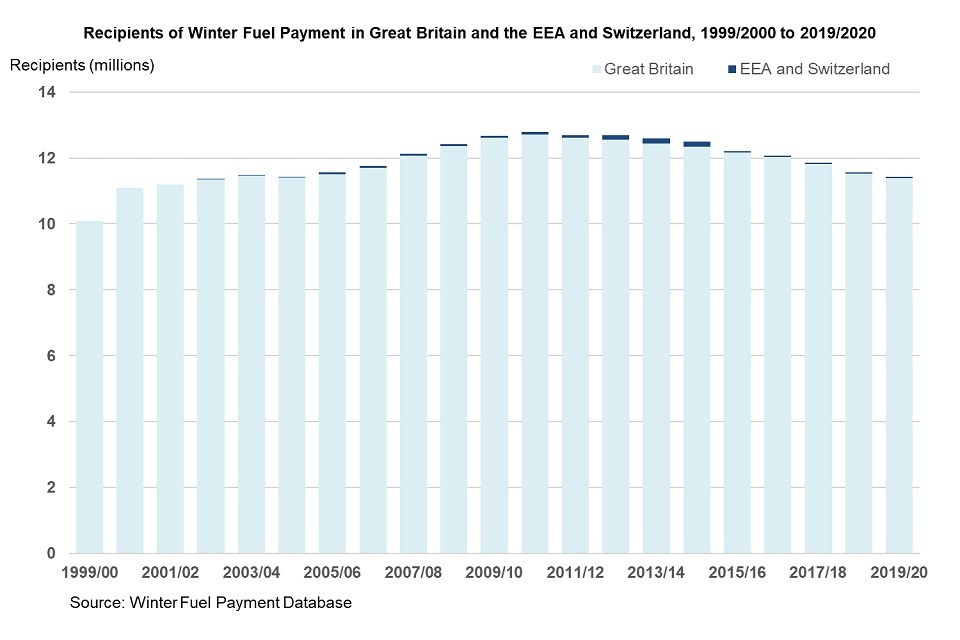
The number of people in Great Britain and the EEA and Switzerland who received Winter Fuel Payment from winter 1999 to 2000 gradually increased each year to winter 2010 to 2011 and has subsequently decreased due to the gradual increase in the State Pension age for women.
In winter 2019 to 2020 the total number of people receiving a Winter Fuel Payment was around 11.4 million. This represents a decrease of 180,000 payments, or 1.5%, from the total for the previous winter, including a drop of 1,000 payments in the EEA and Switzerland.
See the data tables accompanying this release for supporting data and additional breakdowns.
2. About Winter Fuel Payment
Winter Fuel Payment was introduced in 1997 aimed at tackling fuel poverty amongst pensioners. It is an annual tax-free payment of between £100 and £300, to those eligible, to help meet the costs of heating their homes in winter.
A payment is generally made between November and December but can extend until the end of March. Previously, the qualifying age to receive the payment was 60, but from 2010 this was increased in line with the changing State Pension age for women. Automatic entitlement is based on the individual(s) being in receipt of State Pension or another social security benefit (not Housing Benefit, Council Tax Reduction, Child Benefit or Universal Credit).
The payment amount is based on their circumstances during the qualifying week, which is usually in the September prior to the winter referenced. From July 2002, the residency criterion was extended beyond those people living in the UK to include those living within the European Economic Area (EEA) and Switzerland during the qualifying week who have a genuine and sufficient link to the UK.
From September 2015, the Winter Fuel Payment ceased to be payable to individuals living in countries where the average winter temperature is warmer than the warmest region of the UK (South-West England). The “temperature link” affected people in 7 countries, meaning that Winter Fuel Payment was no longer payable to people living in Cyprus, France, Gibraltar, Greece, Malta, Portugal or Spain.
Read more information on claiming Winter Fuel Payment.
3. All Winter Fuel Payment recipients
Recipients are the number of people recorded on the Winter Fuel Payment administrative system, from winter 1999 to winter 2020.
See the data tables accompanying this for supporting data and additional breakdowns.
The number of recipients of Winter Fuel Payment is decreasing in Great Britain and in the EEA and Switzerland. The total number of people receiving a Winter Fuel Payment continues to follow a decreasing trend started in winter 2011 to 2012.
Recipients of Winter Fuel Payment by location, and by gender (for GB only), 1999 to 2020
| Winter | All cases (thousands) | GB Resident (thousands) | GB Resident (Female) (thousands) | GB Resident (Male) (thousands) | EEA and Switzerland residents (thousands) |
|---|---|---|---|---|---|
| 1999-2000 | 10,084 | 10,084 | 6,241 | 3,843 | - |
| 2000-2001 | 11,106 | 11,106 | 6,313 | 4,793 | - |
| 2001-2002 | 11,202 | 11,202 | 6,310 | 4,892 | - |
| 2002-2003 | 11,356 | 11,348 | 6,350 | 4,998 | 8 |
| 2003-2004 | 11,486 | 11,468 | 6,388 | 5,080 | 18 |
| 2004-2005 | 11,430 | 11,401 | 6,285 | 5,116 | 29 |
| 2005-2006 | 11,555 | 11,515 | 6,337 | 5,218 | 40 |
| 2006-2007 | 11,750 | 11,703 | 6,395 | 5,308 | 48 |
| 2007-2008 | 12,123 | 12,069 | 6,569 | 5,500 | 54 |
| 2008-2009 | 12,421 | 12,357 | 6,698 | 5,659 | 64 |
| 2009-2010 | 12,681 | 12,610 | 6,811 | 5,799 | 71 |
| 2010-2011 | 12,783 | 12,710 | 6,854 | 5,855 | 73 |
| 2011-2012 | 12,686 | 12,612 | 6,796 | 5,814 | 74 |
| 2012-2013 | 12,683 | 12,562 | 6,767 | 5,795 | 121 |
| 2013-2014 | 12,585 | 12,446 | 6,705 | 5,741 | 139 |
| 2014-2015 | 12,489 | 12,349 | 6,672 | 5,677 | 140 |
| 2015-2016 | 12,215 | 12,172 | 6,603 | 5,569 | 42 |
| 2016-2017 | 12,025 | 11,984 | 6,502 | 5,482 | 42 |
| 2017-2018 | 11,808 | 11,767 | 6,359 | 5,408 | 41 |
| 2018-2019 | 11,569 | 11,529 | 6,208 | 5,321 | 40 |
| 2019-2020 | 11,391 | 11,352 | 6,113 | 5,239 | 39 |
Source: Winter Fuel Payment Database
Following the gradual increase in the number of Winter Fuel Payment recipients (all cases) since winter 1999 to 2000 the number has been decreasing slowly over the last 9 years, since the increase to women’s State Pension age began in 2010, with the total number of Winter Fuel Payment recipients in 2019 to 2020 standing at 11.4 million people. This represents a decrease of 180,000 recipients, or 1.5%, since winter 2018 to 2019.
A similar trend was seen in the number of recipients in Great Britain, which stood at 11.35 million people in winter 2019 to 2020, a decrease of 180,000 recipients, or 1.5%, since winter 2018 to 2019.
In winter 2019 to 2020 the number of EEA and Switzerland residents eligible for Winter Fuel Payment was 39,000, a drop of 1,000, or 2.9%, from winter 2018 to 2019, which is the fifth decrease since 2014 to 2015. This group represents 0.3% of the total recipients of Winter Fuel Payment.
There were no changes in eligibility for those living in the EEA and Switzerland for winter 2019 to 2020 from the previous year.
Some cases recorded on the administrative system, may not result in a payment: for example, if the person dies or if invalid bank account or address details have been given. Conversely, late payments are sometimes made to people that are not on the system at the time. This means that the actual number of payments made could be slightly different.
The number of recipients of Winter Fuel Payment in Great Britain is decreasing in those aged under 70 and increasing in those aged 70 and above.
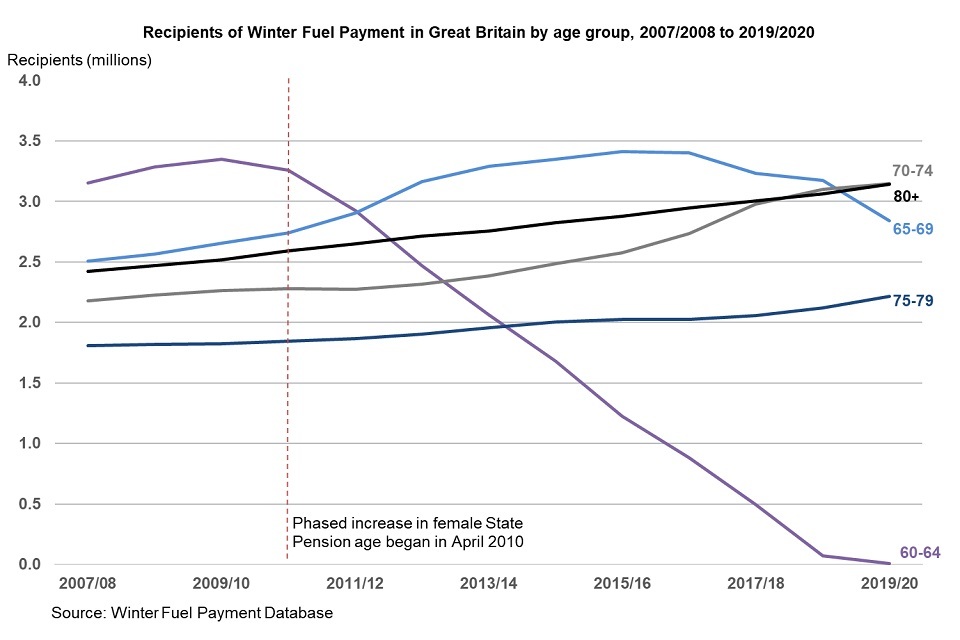
The general increase in the number of pensioners overall has been off-set by the gradual increase in the women’s State Pension age, introduced in April 2010, and, therefore, the age of entitlement for Winter Fuel Payment.
Under current legislation, State Pension age for women equalised with State Pension age for men at 65 years in 2018. This has seen the number of people aged 65 to 69 receiving Winter Fuel Payment decrease by 340,000 people, to 2.8 million people in winter 2019 to 2020. All the older age groups have increased in size between winter 2018 to 2019 and winter 2019 to 2020.
This has seen the number of people aged 65 to 69 receiving Winter Fuel Payment
The State Pension age for both men and women will increase from 65 to 66 years between December 2018 and October 2020. The Pensions Bill 2013 to 2014 contains provision for a State Pension age of 67 years to be reached by 2028. More information can be found in the State Pension age timetables.
More than half of Winter Fuel Payment recipients in Great Britain are women.
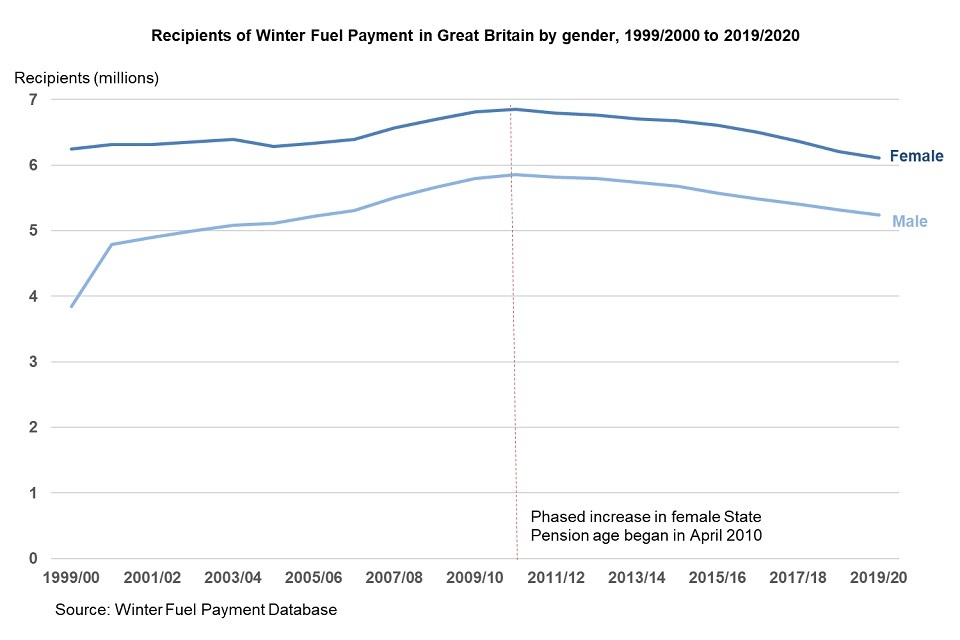
When comparing the number of Winter Fuel Payment recipients in Great Britain by gender since winter 1999 to 2000, the number of females is consistently higher, by approximately one million, than the number of males every year. In winter 2019 to 2020 in Great Britain there were 6.1 million women and 5.2 million men in receipt of Winter Fuel Payment, representing 54% and 46% of the total respectively.
The number of recipients of Winter Fuel Payment is decreasing in the EEA and Switzerland.
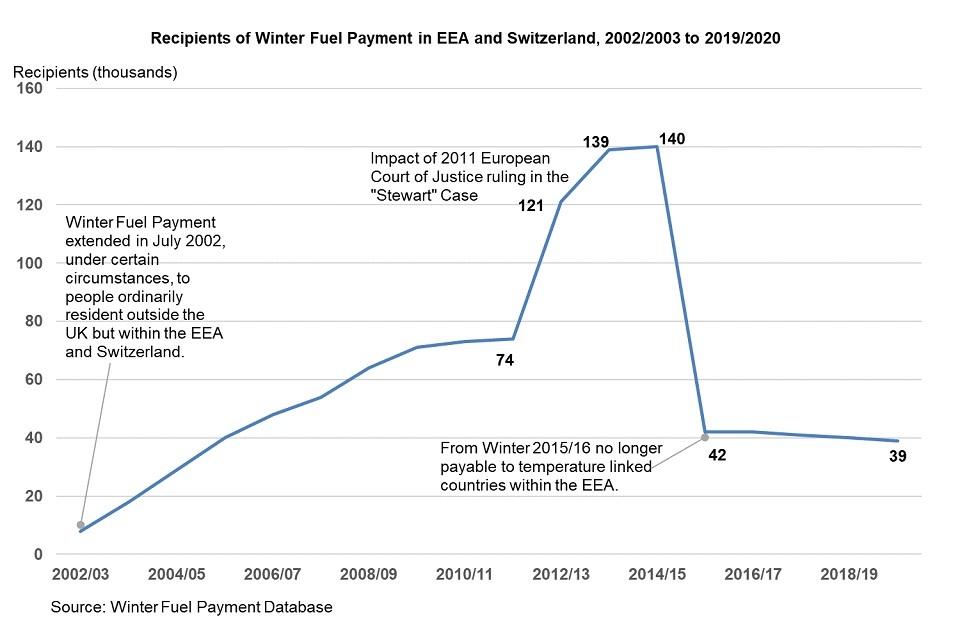
The Winter Fuel Payment was initially available only to people who were normally resident in the UK. The eligibility was extended in July 2002, under certain circumstances, to people ordinarily resident outside the UK, but within the EEA and Switzerland. They were further extended again in June 2003 to certain third country nationals (nationals of non-EU countries).
The number of recipients of Winter Fuel Payment resident in the EEA or Switzerland gradually increased and in winter 2012 to 2013 there was a sharp rise from 74,000 to 121,000. This represented an increase of 63% since winter 2011 to 2012. By winter 2014 to 2015 a peak of 140,000 had been reached.
The sharp rise followed a 2011 European Court of Justice ruling in the “Stewart” Case that meant, as of winter 2012 to 2013, people who live in another EEA country or Switzerland and have a genuine and sufficient link to the UK (for example, that the person has lived or worked in the UK for the majority of their working life), are potentially eligible to receive a Winter Fuel Payment, regardless of whether they previously had entitlement to it whilst living in the UK.
Prior to winter 2012 to 2013 only those who had an existing entitlement to a Winter Fuel Payment before moving to another EEA country or Switzerland were eligible.
From September 2015, the Winter Fuel Payment ceased to be payable to individuals living in countries where the average winter temperature is warmer than the warmest region of the UK (South-West England). The “temperature link” affected people in 7 countries, meaning that Winter Fuel Payment was no longer payable to people living in Cyprus, France, Gibraltar, Greece, Malta, Portugal or Spain.
This change resulted in a marked reduction in the numbers of payments made to those in the EEA and Switzerland and in winter 2015 to 2016 there were 42,000 recipients in these areas, a decrease of 70% on winter 2014 to 2015.
In winter 2019 to 2020 the figure of 39,000 recipients remains close, but slightly lower, than the previous year, with no new countries being included in temperature link introduced in winter 2015 to 2016.
Read section 6.1 on this page for more details on the EEA and Switzerland.
More than half of Winter Fuel Payment recipients in the EEA and Switzerland are men.
Recipients of Winter Fuel Payment in EEA and Switzerland by gender, winter 2019 to 2020
| Gender | Recipients in EEA and Switzerland |
|---|---|
| Male | 20,580 (53%) |
| Female | 18,400 (47%) |
Source: Winter Fuel Payment database
In winter 2019 to 2020 in the EEA and Switzerland there were 18,000 women and 21,000 men in receipt of Winter Fuel Payment, representing 47% and 53% of the total respectively.
4. Households in Great Britain
The number of households in which there are people on the Winter Fuel Payment administrative system. These figures will be lower that the recipient figures as there could be more than one member of the same household entitled to a payment.
The number of households in Great Britain receiving Winter Fuel Payment is decreasing.
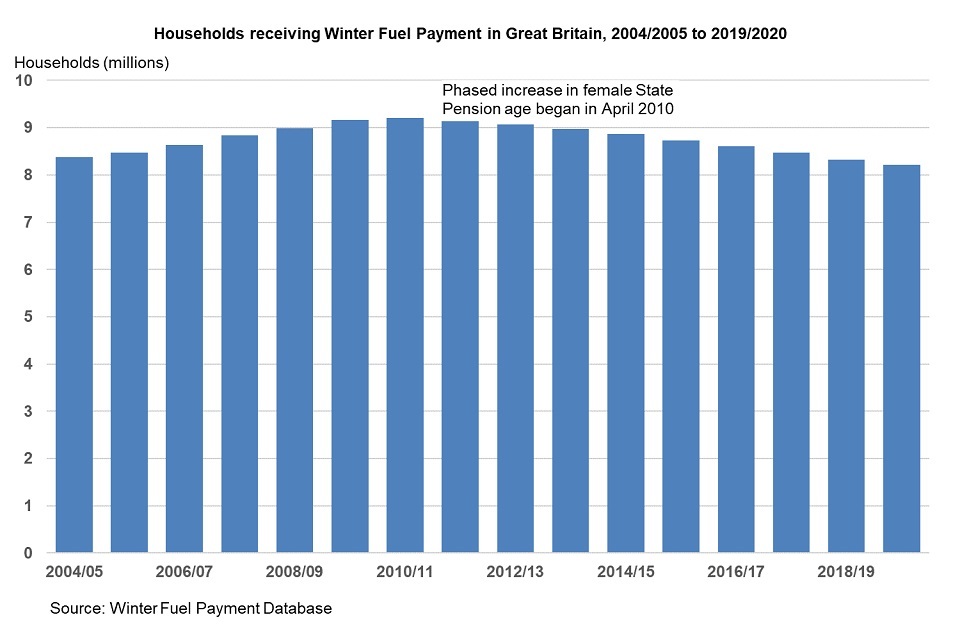
Following an increase in the number of households in Great Britain in receipt of Winter Fuel Payment from winter 2004 to 2005 and winter 2010 to 2011, the numbers have gradually declined. As with the recipient figures, this decrease is due to the rise in women’s State Pension age since April 2010. The general increase in the number of pensioners has been off-set by the gradual increase in the women’s State Pension age and, therefore, the age of entitlement for Winter Fuel Payment.
In winter 2019 to 2020, the number of households in Great Britain in receipt of Winter Fuel Payment was 8.2 million, showing a decrease of 110,000, or 1.3%, since winter 2018 to 2019.
See the data tables accompanying this for supporting data and additional breakdowns.
The largest number of households in Great Britain receiving Winter Fuel Payment are in the South East, and the smallest in the North East.
Winter Fuel Payment households in Great Britain by region, winter 2019 to 2020
| Region | Winter Fuel Payment households and % |
|---|---|
| South East | 1,204,260 (15%) |
| North West | 954,960 (12%) |
| South West | 840,990 (10%) |
| East | 833,310 (10%) |
| West Midlands | 760,850 (9%) |
| London | 746,860 (9%) |
| Yorkshire and the Humber | 707,410 (9%) |
| Scotland | 706,710 (9%) |
| East Midlands | 637,780 (8%) |
| Wales | 450,780 (5%) |
| North East | 368,680 (4%) |
Source: Winter Fuel Payment database
Variations are seen in the regional proportions of households in Great Britain receiving Winter Fuel Payment.
The largest number of households in Great Britain who received Winter Fuel Payment in winter 2019 to 2020 were in the South East with 1.2 million households, or 15% of the total, followed by the North West with 950,000 households, or 12% of the total. The smallest number of households were in Wales with 450,000 households, or 5% of the total, and the North East with 370,000 households, or 4% of the total.
5. Payments made to those living in EEA or Switzerland
The number of payments made via the Winter Fuel Payment System differs from the statistics from the Winter Fuel Payment Database (shown in the sections above), which show the number of payments that are sent to be processed following data matching; some of these cases may not actually receive a payment as issues may emerge during processing that result in clients not being entitled. For this reason, the two sets of statistics, although close, do not match.
The number of payments made to those living in the EEA or Switzerland is decreasing.
Number of Winter Fuel Payments made and expenditure on payments to those living in EEA and Switzerland, 2002 to 2020
| Winter | Total Number of Payments made (thousands) | Expenditure on Payments made (£millions) | Proportion of Total WFP Expenditure (%) |
|---|---|---|---|
| 2002-03 | 8 | 1.009 | 0.06 |
| 2003-04 | 17 | 2.964 | 0.15 |
| 2004-05 | 27 | 5.548 | 0.28 |
| 2005-06 | 40 | 6.415 | 0.32 |
| 2006-07 | 48 | 7.843 | 0.39 |
| 2007-08 | 56 | 8.982 | 0.43 |
| 2008-09 | 65 | 13.518 | 0.50 |
| 2009-10 | 71 | 15.207 | 0.56 |
| 2010-11 | 73 | 15.593 | 0.57 |
| 2011-12 | 75 | 12.760 | 0.59 |
| 2012-13 | 120 | 21.413 | 1.00 |
| 2013-14 | 135 | 23.716 | 1.11 |
| 2014-15 | 138 | 24.519 | 1.16 |
| 2015-16 | 42 | 8.097 | 0.39 |
| 2016-17 | 41 | 8.185 | 0.40 |
| 2017-18 | 40 | 8.130 | 0.40 |
| 2018-19 | 40 | 8.098 | 0.40 |
| 2019-20 | 38 | 7.952 | 0.40 |
Source: Winter Fuel Payment system
For comparison read the Benefit expenditure and caseload figures.
The number of payments made to people living in the EEA and Switzerland, and the associated expenditure, increased between winter 2002 to 2003 and winter 2014 to 2015, but winter 2015 to 2016 saw a large decrease, and the figures have continued to decrease at a smaller rate since then.
With a total of 38,000 payments made in winter 2019 to 2020, this shows a decrease of 1,600 payments, or 4.1%, compared to winter 2018 to 2019, and expenditure has decreased by £146,000, or 1.8%, to just under £8 million over the same time period.
See Section 6.1 on this page for detailed changes to eligibility for Winter Fuel Payment.
The majority of payments made outside of Great Britain are to those living in Republic of Ireland.
| Country | Winter Fuel Payments made | Percentage |
|---|---|---|
| Republic of Ireland | 29,645 | 78% |
| Germany | 2,265 | 6% |
| Italy | 1,735 | 5% |
| Netherlands | 625 | 2% |
| Bulgaria | 610 | 2% |
| Switzerland | 475 | 1% |
| Poland | 435 | 1% |
| Others | 2,120 | 6% |
Source: Winter Fuel Payment system
For those people living in eligible EEA countries and Switzerland, those in the Republic of Ireland received 78% of the payments made in winter 2019 to 2020. Those in Germany and Italy received 6% and 5% respectively.
The European Economic Area (EEA) is made up of all 27 EU countries plus Iceland, Liechtenstein and Norway, which are not members of the EU. Read further information.
From winter 2015 to 2016 a change to the entitlement conditions meant that the Winter Fuel Payment was no longer payable to people living in Cyprus, France, Gibraltar, Greece, Malta, Portugal or Spain.
Read more detailed tables showing the numbers of payments made and expenditure, broken down by country.
6. About these statistics
This is a summary of the latest National Statistics about Winter Fuel Payment. Data are released on an annual basis in September.
The statistics are released annually alongside tables containing more detailed data and further breakdowns. For further information about data collection and processing for this publication see the background information and methodology statement.
Find previous releases of this data.
These statistics were released on 23 September 2020 according to the arrangements approved by the UK Statistics Authority.
The UK Statistics Authority has designated these statistics as National Statistics, in accordance with the Statistics and Registration Service Act 2007 and signifying compliance with the Code of Practice for Official Statistics. Designation can be broadly interpreted to mean that the statistics:
- meet identified user needs
- are well explained and readily accessible
- are produced according to sound methods
- are managed impartially and objectively in the public interest Once statistics have been designated as National Statistics it is a statutory requirement that the Code of Practice shall continue to be observed.
6.1 European Economic Area (EEA) and Switzerland
The European Economic Area (EEA) is made up of all 27 EU countries plus Iceland, Liechtenstein and Norway, which are not members of the EU.
In 1997 (start of the Winter Fuel Payment scheme): Austria, Belgium, Denmark, Finland, France, Germany, Greece, Ireland, Italy, Luxembourg, Netherlands, Portugal, Spain, Sweden and United Kingdom.
On 1 May 2004, the following countries joined: Cyprus, Czech Republic, Estonia, Hungary, Latvia, Lithuania, Malta, Poland, Slovakia and Slovenia
On 1 January 2007, the following countries joined: Bulgaria, Romania
On 1 July 2013, the following country joined: Croatia.
Switzerland is not a member of the EEA, but an agreement from 1 June 2002 means that the European Community rules on social security apply from that date. As a result, the Winter Fuel Payment may be paid in Switzerland in some circumstances.
From winter 2015 to 2016 a change to the entitlement conditions meant that the Winter Fuel Payment was no longer payable to people living in Cyprus, France, Gibraltar, Greece, Malta, Portugal or Spain.
6.2 Supplementary statistics
The Winter Fuel Payment data (both recipients and households) underlying the charts and figures featured in this summary are available as a separate set of statistical tables. These tables contain further breakdowns by local authority, gender and age, and Parliamentary constituency, gender and age.
A Winter Fuel Payment is made annually to all pensioners between November and December and is a fixed amount that is not weather dependant. However, in periods of extreme cold weather between November and March, the Cold Weather Payment scheme provides additional support to pensioners in receipt of Pension Credit and other individuals vulnerable to cold weather by providing an extra £25 payment for every seven-day period of below zero degrees Celsius temperatures in their area.
Read the statistics on Cold Weather Payment for 2019 to 2020.
These statistics are based on the estimated number of benefit units linked to each weather station that is eligible for a Cold Weather Payment. A benefit unit is an adult and their partner (if applicable) and any dependent children living with them. Read more information on claiming a Cold Weather Payment.
Read the statistics released on Fuel Poverty in England by the Department for Business, Energy & Industrial Strategy (BEIS).
Fuel poverty in England is measured by the Low Income High Costs definition, which considers a household to be in fuel poverty if:
- they have required fuel costs that are above average (the national median level)
- were they to spend that amount they would be left with a residual income below the official poverty line
The key drivers behind fuel poverty are:
- the energy efficiency of the property (and therefore, the energy required to heat and power the home)
- the cost of energy
- household income
6.3 Other National and Official Statistics
Find details of other National and Official Statistics produced by the Department for Work and Pensions (DWP).
Find the schedule of statistical releases over the next 12 months and a list of the most recent releases.
In addition, users can find links to DWP additional statistical analyses that have not been included in our standard publications.
7. Contact information and feedback
For more information, please contact clint.woo@dwp.gov.uk
DWP would like to hear your views on our statistical publications. If you use any of our statistics publications, we would be interested in hearing what you use them for and how well they meet your requirements. Please email DWP stats-consultation@dwp.gov.uk
Please find the on-going questionnaire, enabling DWP to target future consultations at interested users; shaping the future direction of statistics development to address user needs; and helping ensure value for money, whilst giving users a structured way of expressing their views.
You can also join the Welfare and Benefit Statistics community on StatsUserNet, DWP announces items of interest to users via this forum, as well as replying to users’ questions.
Lead Statistician: jenny.kay1@dwp.gov.uk
Produced by: clint.woo@dwp.gov.uk
ISBN: 978-1-78659-265-1
